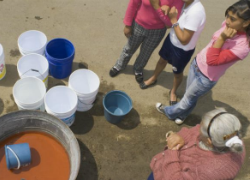A recent hiccup in Mexico City’s water quality has sparked new debate around the metropolis’ water system. In the last few weeks, Mexico City residents have been complaining about their tap water. Inhabitants have noticed an extraordinarily strange taste and smell of their water, but the country’s National Water Commission (CONAGUA) assures the public that the water’s quality remains intact. It appears the culprit of the foul water is an algae growth inside the Valle de Bravo dam that is part of the Cutzamala water system. Cutzamala hydrates Mexico City and is a network of seven dams and Valle de Bravo is one of the three largest dams in the network.
Various activist groups, including the Coalition of Mexican Organizations for the Right To Water (COMDA), are rallying their memberships to demand transparency from CONAGUA. CONAGUA is the entity responsible for monitoring the integrity of the water held inside the Valle de Bravo dam, and earlier this week, the Commission released a statement assuring the public that, while there is more algae living inside the dam, the new growth is not harmful to consumers. However, CONAGUA clarified that it is still collecting information to assess the impacts of the outgrowth.
Mexico City has a long history of water troubles. The City started off as a lake when the Aztecs founded it in the 1300s. When the Spanish took control of the city, they drained most of the lake – literally sinking the earth beneath the city’s feet. This gave the city the opportunity to sprawl throughout the Valley of Mexico, but centuries of population growth and increased water consumption from the aquifer beneath the City is causing it to sink. Mexico City is sinking down into the lakebed at about three inches per year. This steady descent wreaks havoc on the already delicate water infrastructure that runs beneath the city and makes it harder each year to pump water into houses and buildings.
Modern day Mexico City continues to encounter water scarcity issues as well. Between droughts and a supremely antiquated and neglected water infrastructure, water service can be intermittent and sporadic. The city’s pipes are reportedly so leaky that about 40% of the water is lost in transit to people’s homes. To boot, the country receives the vast majority of its precipitation during four months out of the year, which makes it difficult to provide a consistent water supply to its population throughout the entire year.

(Houston Chronicle)
Solutions to these growing problems are tenuous. And, despite a slight global decline in private sector participation in what have traditionally been publicly held utilities, Mexico City continues to rely on private entities to supply its inhabitants with potable water. The city’s water distribution system is divided into 16 districts – private companies are present in all of them. The Mexican media is quick to point out that bottled water is a form of water privatization. Mexico consumes an enormous amount of bottled water. As of 2010, its annual bottled water consumption was measured at 234 liters per capita. This aside, more obvious forms of private entity participation are evidenced throughout the country. From facilitating local municipal water services to constructing water treatment plants and large-scale dam projects, private entities have long been deeply established in Mexico’s water utilities. Opponents argue that even in quasi-privatization endeavors where the government leases a damn project or municipal water system to a private company for a certain period of time, the public still suffers. What tends to happen is that a government will contract a water treatment plant or dam project out to a private company, that company will finance and manage the project and then reap its benefits for the length of the contract – say 30 years. Then, the company turns the project over to the government after reaping the benefits of the project’s most lucrative and efficient years, typically leaving the government with a plant or a dam or a water system that, by that time, is outdated and poorly maintained.
For now though, funny smells and tastes aside, CONAGUA maintains that Mexico City has the best, purist and tastiest tap water in the Republic.
Gaby Coria is a rising third year law student at the University of Denver. She is a Staff Editor on The View From Above.


